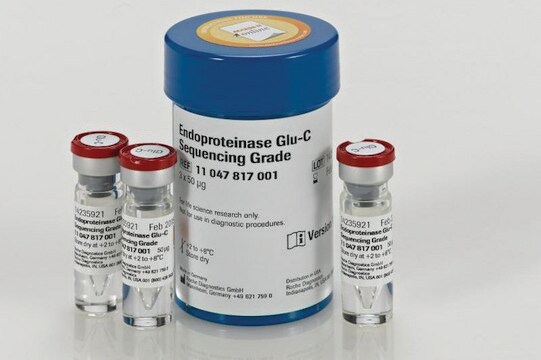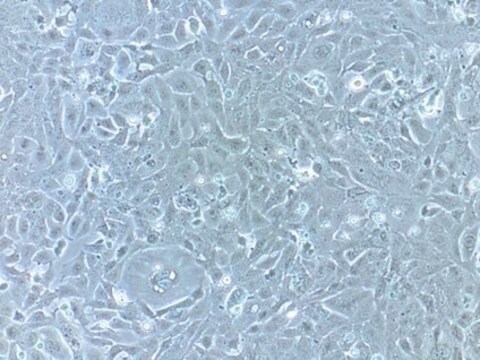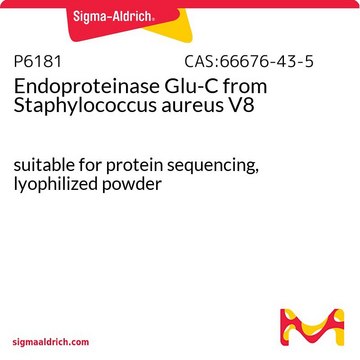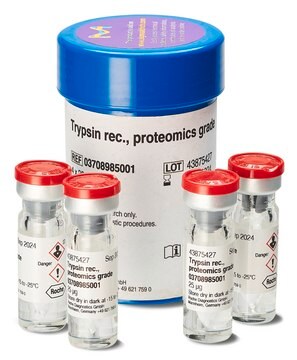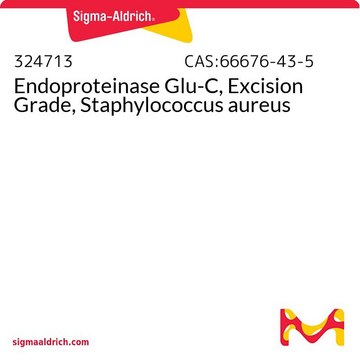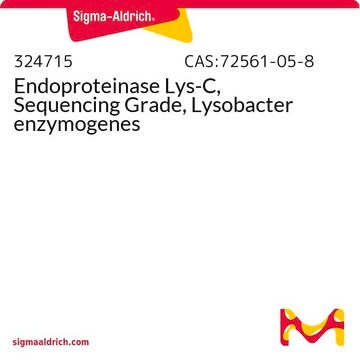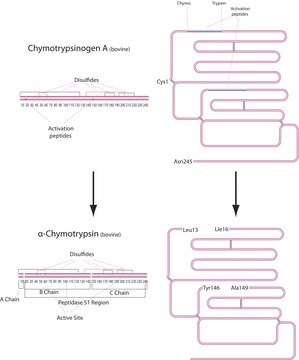ENDOARGS-RO
Roche
Endoproteinase Asp-N Sequencing Grade
from Pseudomonas fragi
Synonym(s):
protease
Sign Into View Organizational & Contract Pricing
All Photos(1)
About This Item
Recommended Products
assay
≥90% (SDS-PAGE)
form
lyophilized
specific activity
≥20000 units/mg protein
mol wt
27 kDa
packaging
pkg of 2 μg (11420488001)
pkg of 3 × 2 μg (11054589001)
manufacturer/tradename
Roche
optimum pH
7.0-8.0
pH range
6.5-9.0
storage temp.
2-8°C
General description
The wild type of Pseudomonas fragi segregates a metalloprotease, which cleaves peptide bonds N-terminally at small hydrophilic amino acids. A mutant of this strain produces the Endoproteinase Asp-N Sequencing Grade, which is isolated as a highly purified and specific protease.
Specificity
Endoproteinase Asp-N Sequencing Grade is a metalloprotease. In phosphate, acetate, or Tris buffers at pH 6.0–8.5, it specifically cleaves peptide bonds N-terminally at aspartic and cysteic acid. If cysteine is reduced or alkylated, only -↓-Asp-X is cleaved.
The specificity of Endoproteinase Asp-N Sequencing Grade is verified with glucagon as a substrate. High concentrations of Endoproteinase Asp-N Sequencing Grade (1 part by weight enzyme with 10 parts by weight glucagon) are incubated to detect traces of impurities like contaminating proteases.
Heat inactivation: The protease is stopped by boiling for 5 minutes.
The specificity of Endoproteinase Asp-N Sequencing Grade is verified with glucagon as a substrate. High concentrations of Endoproteinase Asp-N Sequencing Grade (1 part by weight enzyme with 10 parts by weight glucagon) are incubated to detect traces of impurities like contaminating proteases.
Heat inactivation: The protease is stopped by boiling for 5 minutes.
Application
Use Endoproteinase Asp-N Sequencing Grade for protein structure analysis and sequence analysis.
Preparation Note
Working concentration: 2 μg /50 μl double-dist. water
One vial (= 2 μg enzyme) is dissolved in 50 μl double-dist. water resulting in a buffer concentration of 10 mM Tris-HCl pH 7.5.
Working solution: Recommended solvent is double-distilled water.
Storage conditions (working solution): -15 to -25 °C
A solution in double-dist. water is stable for 1 week at maximum at 2 to 8 °C and for about 1 month at -15 to -25 °C; repeated thawing should be avoided.
One vial (= 2 μg enzyme) is dissolved in 50 μl double-dist. water resulting in a buffer concentration of 10 mM Tris-HCl pH 7.5.
Working solution: Recommended solvent is double-distilled water.
Storage conditions (working solution): -15 to -25 °C
A solution in double-dist. water is stable for 1 week at maximum at 2 to 8 °C and for about 1 month at -15 to -25 °C; repeated thawing should be avoided.
Reconstitution
Lyophilized Endoproteinase Asp-N sequencing grade is reconstituted in 50 μl double-dist. water. This results in a buffer concentration of 10 mM Tris-HCl, pH 7.5. In order to avoid autolysis the incubation temperature should not exceed 37 °C.
Other Notes
For life science research only. Not for use in diagnostic procedures.
Storage Class
11 - Combustible Solids
wgk_germany
WGK 1
flash_point_f
does not flash
flash_point_c
does not flash
Certificates of Analysis (COA)
Search for Certificates of Analysis (COA) by entering the products Lot/Batch Number. Lot and Batch Numbers can be found on a product’s label following the words ‘Lot’ or ‘Batch’.
Already Own This Product?
Find documentation for the products that you have recently purchased in the Document Library.
Customers Also Viewed
Ming-Ming Li et al.
Nature communications, 4, 1832-1832 (2013-05-16)
Regulation of actomyosin dynamics by post-transcriptional modifications in cytoplasmic actin is still poorly understood. Here we demonstrate that dioxygenase ALKBH4-mediated demethylation of a monomethylated site in actin (K84me1) regulates actin-myosin interaction and actomyosin-dependent processes such as cytokinesis and cell migration.
Javier Fernandez-Martinez et al.
The Journal of cell biology, 196(4), 419-434 (2012-02-15)
The nuclear pore complex (NPC) is a multiprotein assembly that serves as the sole mediator of nucleocytoplasmic exchange in eukaryotic cells. In this paper, we use an integrative approach to determine the structure of an essential component of the yeast
Our team of scientists has experience in all areas of research including Life Science, Material Science, Chemical Synthesis, Chromatography, Analytical and many others.
Contact Technical Service
